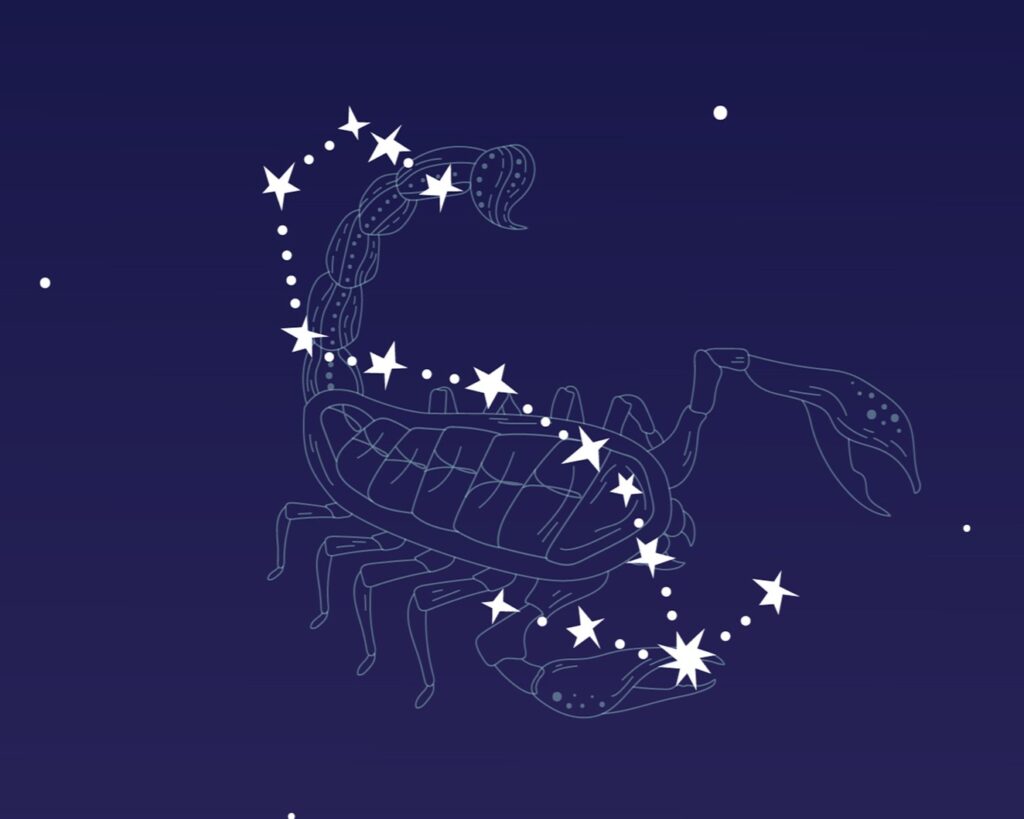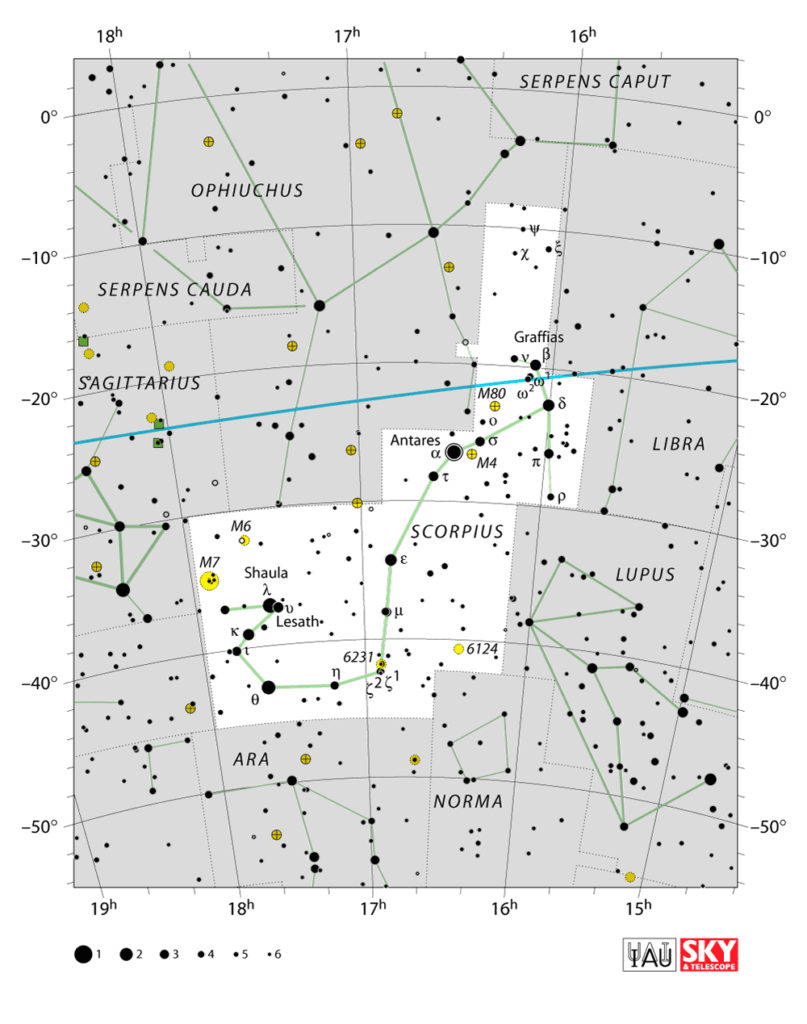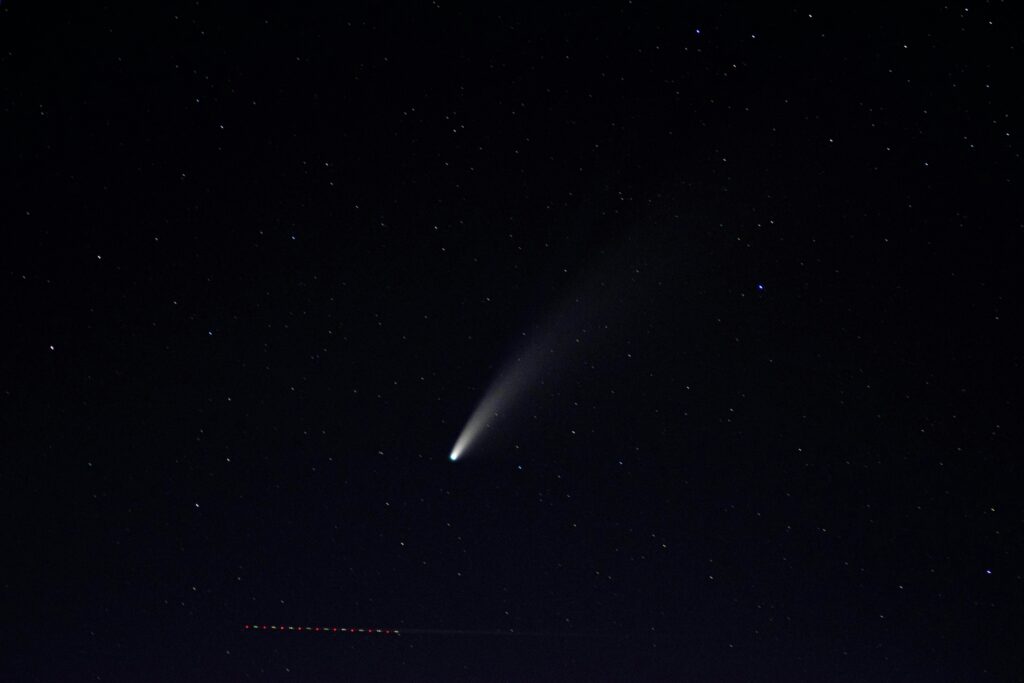Stargazing with Scorpius
© freepik/tartila
Table of Contents
Scorpius, the striking constellation of the southern hemisphere, graces the night sky with its distinctive shape and prominent celestial features. As one of the 88 officially recognized constellations positioned near the heart of the Milky Way, this zodiacal constellation showcases a mesmerizing array of stars, clusters, and nebulae.
The most prominent star in Scorpius is Antares, often referred to as the “heart of the scorpion.” With its distinctive reddish hue, Antares adds a fiery brilliance to the constellation and serves as a beacon for stargazers navigating the celestial landscape. Notable features include the globular cluster Messier 4 (M4), the open cluster Messier 7 (M7) known as Ptolemy’s Cluster, and the visually striking Butterfly Cluster (M6).
As Scorpius graces the southern hemisphere, it offers a celestial panorama of rich star fields and the luminous band of the Milky Way. Whether observed from a dark sky location or explored through the lens of a telescope, Scorpius invites celestial enthusiasts to delve into its mythological narratives and marvel at the cosmic wonders it unveils in the vastness of the southern night sky.
HISTORY OF SCORPIUS

The Scorpius constellation has a storied history that stretches back to ancient civilizations, where it played a significant role in the mythologies of various cultures. One of the most enduring tales associated with Scorpius comes from Greek mythology, where it is linked to the myth of Orion and the scorpion. In this narrative, the giant hunter Orion boasted of his invincibility, attracting the attention of the Earth goddess Gaia. To humble Orion, she sent a giant scorpion to confront him. The ensuing battle between Orion and the scorpion resulted in both of their deaths and the gods immortalized them as constellations in the night sky, with Scorpius forever chasing Orion across the celestial dome.
In ancient Egypt, Scorpius had its significance. The constellation was associated with Serqet, a protective deity often depicted as a scorpion. Serqet was revered for her ability to ward off venomous creatures, making the scorpion a symbol of protection and healing.
The Babylonians, among the earliest astronomers, also recognized Scorpius and included it in their star catalogues. The constellation’s presence in these ancient records indicates its importance in the celestial observations of the time.
In Indian astronomy, Scorpius is known as Vrishchika and is associated with the nakshatra Jyeshtha. In Hindu mythology, this constellation is often linked to various deities and holds astrological significance.
As Scorpius is positioned along the ecliptic, the apparent path of the Sun, it is part of the zodiac constellations. Ptolemy, the ancient Greek astronomer, included Scorpius in his influential work, the Almagest, solidifying its place among the recognized constellations.
ASTRONOMICAL FEATURES

The Scorpius constellation, situated prominently in the southern hemisphere, is adorned with various astronomical features that captivate observers and astronomers alike. Here are some key celestial elements within Scorpius:
ALPHA SCORPII
Antares, designated as Alpha Scorpii, is a celestial giant with a reddish glow. Positioned at the heart of the Scorpius constellation, this red supergiant is one of the most recognizable stars visible from Earth. With an apparent magnitude that varies between +0.6 and +1.6, Antares is classified as one of the brightest stars in the night sky.
Antares is a colossal star, boasting a diameter approximately 700 times that of the Sun. Its reddish hue is a characteristic feature of cooler, M-type stars, and it serves as a captivating celestial marker within the Scorpius constellation. Located at a distance of around 550 light-years from Earth, Antares holds a significant position in our cosmic neighbourhood.
This remarkable star is part of a binary system, accompanied by a blue-white main-sequence companion known as Antares B. Its prominence in the night sky, along with its mythological associations and role in shaping the Scorpius constellation, makes Antares a celestial gem that has fascinated astronomers and stargazers throughout the ages. Observing Antares as it gleams in the southern hemisphere provides a profound connection to the vastness of the cosmos and the intricate tapestry of stars that adorn our night sky.
MESSIER 4
Messier 4 (M4) stands as a captivating celestial jewel within the Scorpius constellation. It is a dense congregation of stars that orbits the galactic center of the Milky Way. Nestled near the bright red giant star Antares, M4 is one of the nearest globular clusters to Earth, lying approximately 7,200 light-years away.
Composed of tens of thousands of ancient stars tightly bound by gravity. The stars within the cluster are significantly older than the majority of stars in the galactic disk, with an estimated age of around 12 billion years. This places M4 among the oldest known globular clusters. Observing M4 through a telescope reveals a densely packed arrangement of stars, forming a spherical structure that appears like a glittering celestial ball. The cluster spans about 75 light-years in diameter, and its stars exhibit a range of colours, primarily due to differences in temperature and composition.
MESSIER 7
Messier 7 (M7), also known as Ptolemy’s Cluster, is a spectacular open star cluster situated in the Scorpius constellation. This celestial gem is easily visible to the naked eye under dark skies and has been admired by astronomers and skywatchers for centuries. The cluster is located at a distance of approximately 980 light-years from Earth and spans a region of the sky about 1.3 degrees wide, equivalent to roughly three times the apparent size of the Moon. Its central region is particularly rich in stars, creating a dazzling display of stellar brilliance.
M7 is composed of over 80 stars, with the brightest members forming a distinctive pattern resembling a butterfly or a small number “7,” which gives the cluster its name. The stars within M7 are loosely bound by gravity, and over time, the cluster will gradually disperse as its member stars follow their separate orbits through the galaxy.
MESSIER 80
Messier 80 (M80) is a striking globular cluster located in the Scorpius constellation, adding to the celestial wonders within the Milky Way. Charles Messier catalogued this dense and spherical cluster on January 4, 1781, and it has since been a captivating object of study for astronomers.
Situated at a distance of approximately 32,600 light-years from Earth, M80 is one of the most densely populated globular clusters in our galaxy. It contains a staggering number of stars, estimated to be around 200,000, densely packed within a region only about 95 light-years in diameter.
The stars in M80 are notably old, with an age estimated to be over 11 billion years. This makes M80 one of the older globular clusters, showcasing the rich history of stellar evolution within our galactic neighbourhood.
THE BUTTERFLY CLUSTER
The Butterfly Cluster, designated as Messier 6 (M6) and also known as the Butterfly Nebula, is a captivating open star cluster situated in the Scorpius constellation. M6 is located at a distance of approximately 1,600 light-years from Earth, and it spans an area of about 20 light-years. The cluster consists of a few hundred stars, primarily young, hot, and blue, creating a visually striking ensemble against the dark backdrop of space. The brightest stars within the cluster form a pattern resembling the outstretched wings of a butterfly, hence its popular name.
This open cluster is relatively young, with an estimated age of around 100 million years. Its formation is associated with the extensive nebulosity in the region, indicating ongoing star formation within the complex.
NEAR THE GALACTIC CENTER
The Scorpius constellation holds a privileged position in the night sky as it lies in the direction of the Milky Way’s galactic center. Positioned near the heart of our galaxy, Scorpius offers a breathtaking panorama of the densest and most dynamic region of the Milky Way.
The galactic center, located in the constellation Sagittarius but observable from Scorpius, is a bustling hub of stellar activity. A myriad of stars, gas, and dust populate this central region. The interplay of gravitational forces, radiation, and energetic phenomena near the galactic center shape the evolution of our galaxy.
THE SCORPION’S TAIL
The Scorpion’s Tail, a distinctive feature of the Scorpius constellation, extends across the southern hemisphere’s night sky and is marked by a series of bright stars forming a celestial arc. At the heart of this cosmic arachnid lies the reddish giant star Antares, often referred to as the “heart of the scorpion.” The stars outlining the scorpion’s tail create a visually striking pattern that has captured the imaginations of skywatchers throughout history.
One of the most prominent and recognizable constellations, Scorpius gets its name from its resemblance to a scorpion, and the tail adds a dramatic touch to its overall appearance. The arrangement of stars in this region creates a captivating visual narrative, evoking the mythical creature that has been a part of cultural stories and astronomical traditions for centuries.
VISIBILITY AND SEASONALITY

The Scorpius constellation, with its distinctive shape resembling a celestial scorpion, graces the night sky in the southern hemisphere. Known for its bright stars and captivating features, Scorpius is visible during specific seasons, dominating the celestial canvas with its unmistakable outline. The visibility and seasonality of Scorpius offer stargazers and astronomers a unique opportunity to explore this prominent constellation, uncovering its celestial treasures and observing its alignment with the Milky Way‘s galactic center.
NORTHERN HEMISPHERE
- Spring: Scorpius is not typically visible during spring in the northern hemisphere. If visible, it remains low on the southern horizon and may be obstructed by atmospheric conditions.
- Summer: Limited visibility of Scorpius in the northern hemisphere during summer. Scorpius may be partially visible near the southern horizon for observers closer to the equator.
- Autumn: Scorpius remains challenging to observe during autumn in the northern hemisphere. It is low on the southern horizon and may not be visible for higher latitudes.
- Winter: Scorpius is not visible during winter in the northern hemisphere. The constellation remains below the horizon or extremely low for observers at northern latitudes.
SOUTHERN HEMISPHERE
- Spring: Scorpius begins to rise in the east after sunset, becoming more visible in the evening sky. It reaches its highest point around midnight, offering an excellent view during spring.
- Summer: Scorpius is at its peak visibility during the southern hemisphere summer. The constellation is high in the sky, providing optimal viewing conditions.
- Autumn: Scorpius remains visible during the early part of autumn in the southern hemisphere. It gradually descends in the west as the season progresses.
- Winter: Scorpius is still visible during winter in the southern hemisphere. While it may not be as high as in summer, it remains a prominent constellation in the night sky.
METEOR SHOWER

The Alpha Scorpiids and Omega Scorpiids are two meteor showers associated with the Scorpius constellation, both radiating from different points within the constellation.
ALPHA SCORPIIDS
- Radiant Point: The Alpha Scorpiids appear to radiate from the star Alpha Scorpii, which is more commonly known as Antares. Antares is the bright and distinctly red supergiant star that marks the heart of the Scorpius constellation.
- Activity Period: The Alpha Scorpiids meteor shower is generally active from late April to early May each year, with the peak occurring around May 6th.
- Characteristics: While not considered a major meteor shower, the Alpha Scorpiids can produce bright meteors, and there is a chance of observing fireballs—exceptionally bright meteors that create a stunning display.
OMEGA SCORPIIDS
- Radiant Point: The Omega Scorpiids, as the name suggests, appear to radiate from a point in the Scorpius constellation associated with the star Omega Scorpii. Omega Scorpii is a binary star system located in the “tail” of the scorpion.
- Activity Period: The Omega Scorpiids are less well-known and less observed compared to some other meteor showers. The activity period and peak may vary, and there is limited information available about this shower.
- Characteristics: Similar to the Alpha Scorpiids, the Omega Scorpiids may produce meteors of varying brightness, but they are not as widely studied or anticipated as more prominent meteor showers.
